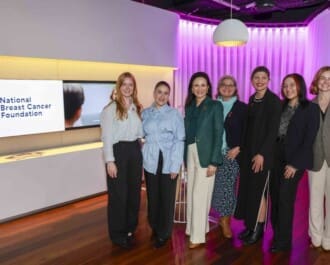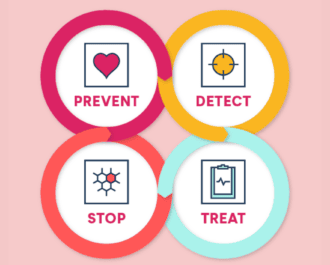
Dr Eliza Whiteside lives in Toowoomba, Queensland, a city with higher than average breast cancer incidence. In Toowoomba 122 women in every 100,000 will be diagnosed with the disease – above the national average of 115 in every 100,000 women.
“I was just 28 years old with a two year old son and had no family history of breast or ovarian cancer in my family. The only breast cancer risk factor I had was being a woman,” says Eliza.
“The finding that Queensland and particularly Toowoomba has an above average incidence of breast cancer is concerning. More research is needed to understand these figures.”
The highest and lowest across the country
Breast cancer is now the most common cancer among Australian women and has the highest incidence of all cancers in Australia.
Recent figures from the Australian Institute for Health and Welfare show that the five suburbs with the highest incidence across the country are all in Queensland. The suburb with the highest incidence is Maryborough at 288 in 100,000 women. The Queensland region of Tablelands East and Kuranda had the lowest incidence in Australia of just 51 in 100,000.
However, overall, women in the Australian Capital Territory have on average the highest rate of diagnosis in the country – well above the national average. The Northern Territory overall had the lowest incidence of breast cancer – significantly below the national average.
Breast cancer incidence
The rate of breast cancer diagnoses in Australia is increasing. In 2017 it is estimated that 17,586 women will be diagnosed with breast cancer – that’s 48 women a day.1 This has increased from 14,290 in 20112 and 13,567 in 20083.
This increasing incidence can be attributed to a few key factors. Australia’s population is growing steadily so the pool of people who could potentially develop breast cancer is larger than in previous decades.
The national screening program offers free mammograms to women over 50 years old to detect breast cancers. This service has increased the number of women known to have breast cancer and saved lives through early breast cancers detection.
Although there are more women being diagnosed with breast cancer, the good news is that more of them are surviving the experience. In the 1980s breast cancer 5-year survival was around 72 per cent and today it has improved to 90 percent4, thanks largely to earlier detection and better treatments.
Research to lower breast cancer incidence
With more women facing a breast cancer diagnosis than ever before, there is an urgent need to look at prevention. Life-saving screening and treatments are vitally important, but research into preventing breast cancer is the only way to reduce the numbers.
There are many ways to reduce a woman’s risk of developing breast cancer. Funded by the National Breast Cancer Foundation, Professor Kelly-Anne Phillips from the Peter MacCallum Institute in Melbourne is investigating breast cancer prevention from a number of angles.
She is studying drugs that could prevent breast cancer or stop it returning in women who have increased breast cancer risk because they have faulty BRCA1 or BRCA2 genes.
An expert in this field, Professor Phillips leads the Australian arm of a huge international study that is looking at how lifestyle risk factors, such as exercise, diet and weight impact a woman’s risk of developing breast cancer.
She has also developed a tool that women and doctors can use to determine their level of risk. Called iPrevent, this online tool is due to be rolled out in the near future. It is designed to help women be informed about their risk so they can make choices that would reduce their chance of facing a breast cancer diagnosis.
The National Breast Cancer Foundation funds many researchers like Professor Phillips who are working towards the aspirational vision of Zero Deaths from breast cancer.
- https://canceraustralia.gov.au/affected-cancer/cancer-types/breast-cancer/breast-cancer-statistics
- Cancer incidence projections 2011-2020, Australian Institute of Health and Welfare, 2012
- Breast cancer in Australia: an overview, Australian Institute of Health and Welfare, 2012
- Breast cancer in Australia: an overview, Australian Institute of Health and Welfare, 2012
More News Articles
View all News



